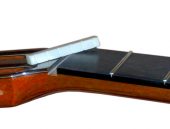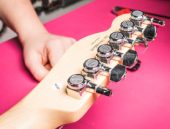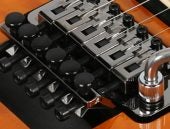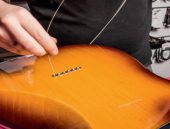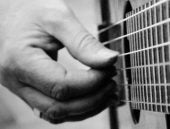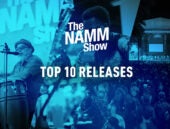Guitarist
-
In this blog, Guestblogger Marc offers a step-by-step explanation of how you can change the nut of your guitar. Whether it’s an electric mode, an acoustic, or classical guitar, or a bass, Marc fills you in on what tools you’ll need and why you would bother changing the nut at all. The conclusion seem to be that it rewards you with an instrument that plays better than it ever did. Read on to find out how and why.
-
The machine heads fitted to the headstock of an electric or acoustic guitar can come in many shapes and sizes: from closed oil-bed machine heads, to open-gear tuners, to the vintage tuners found blessing the heads of a Stratocaster or Telecaster, to the sunken tuning mechanics of a classical guitar. There is one flavour of machine head that is actually often demanded by guitarists: the locking tuner. Find out why right here.
-
Can a guitar or bass guitar that you buy online be set up and adjusted before it’s shipped off? This is a question that we get asked a lot. As such, we’ve put this little blog together to explain what actually goes into setting up a guitar or bass and why it’s not possible to – or actually understandable that we don’t – set up a brand new guitar before sending it out to you.
-
If you can already see yourself pulling off mad dive-bombs and slick dime-squeals after witnessing a pro player showcase their skills, chances are you’ll end up buying an electric guitar with a floating tremolo bridge yourself – perhaps even one with a genuine Floyd Rose. What many beginners don’t realise, however, is that a floating bridge is rather sophisticated, which can quickly lead to confusion and irritation. To help you out, I’m going to show you exactly how you can tune a Floyd Rose, Ibanez Edge or any other comparable tremolo bridge system in just five steps.
-
Guestblogger Marc tells all about how to repair the electronics of your electric guitar with your own two hands and get rid of that hum, crackle, or actually get some sound out of it. From the tools you’ll need to get the job done properly, to a run through of what you need to do: Marc lays it all out and makes it clear that it’s much simpler than you think and anyone with the will and the right tools can do it themselves! And if you take the plunge, you get the added benefit of noise free tone, an in-house repair shop and the chance to get to know your guitar a little more intimately.
-
Have the strings of your electric guitar seen better days? Has the top string snapped or are they sounding a wee bit dead? Then it’s probably about time that you give your cherished instrument the love it deserves by gifting it with a fresh set of strings. Only … re-stringing a guitar for a beginner might be a little bit daunting.
-
One of the things that makes the electric guitar so seductive is the insane range of different sounds you can get out of a single instrument. The electric guitar can be used to make something heart-breakingly subtle, just as easily as it can be deployed to unleash ear-splitting brutality. This blog deals with the latter – and we’re not talking about just cranking up the volume and hoping for the best, but the subtle art of guitar distortion in all its forms. That’s not to say you can’t crank it up. Back in the day, before the dawn of effects pedals, the only way to get a distorted sound was to push the volume of an amplifier so far that it started to crack. Thankfully, those times are gone and we can now enjoy the magic offered by distortion stompboxes, even at a more sociable volume.
-
If you want your axe to stay in tune during a serious dive-bomb, you’ll need a Floyd Rose tremolo with a special double-locking system. Since this system can look a little daunting to set up, we’re going to show you exactly how this type of guitar bridge works, and how you can string up and intonate it.
-
While it is possible, playing Rolling Stones classics like Brown Sugar and Start Me Up in standard tuning will most likely leave you utterly disappointed and forced into impossible finger positions. Granted, the rhythm parts can be played using simplified power chords, but that still won’t get you that signature Stones sound. So how does Keith Richards pull it off? Well, as someone who knows how not to take things too seriously, Richards is probably the first to admit he really isn’t the best guitarist ever to have roamed the stage. The trick here, is open G tuning.
-
When playing the guitar without a plectrum, you use your fingers. This playing style is also known as ‘fingerstyle’ or ‘fingerpicking’. A great advantage of playing in this way is that you can play multiple strings with more precision (plucking is the better word for it). Also, you get a much warmer sound out of your guitar. In this blog, I’ll take you through the basics of fingerpicking: which fingers to use and the best playing position, and whether you need to play with your nails or with your fingertips. If you’d prefer to just play with a plectrum, then check out our purpose-made plectrum blog.
-
Reading guitar tabs isn’t only easier than reading traditional notations, it’s also lot more intuitive. Tabs, short for tablature, show you exactly which string to play and which fret to press down on it at a single glance. It’s worth knowing how these work because they’re used all over the internet and in various guitar learning methods and songbooks. To learn everything you need to know about guitar tabs, simply sit back and enjoy this blog!
-
As a well seasoned online guitar teacher, Guest-blogger, Michel Penterman often gets asked the question: “Do I have to learn to read music to start playing the guitar, or can I use guitar tablature, or just learn all the chords?” In this blog, Michel sums up the pros and cons of each approach and offers a nice, simple conclusion!

